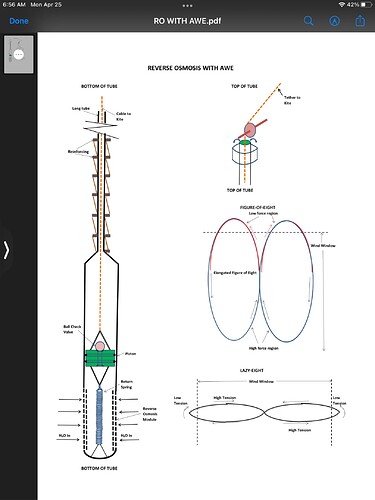SUMMARY
Conventional RO compresses water using a high pressure pump and passes the water through a suitable membrane. An alternate method is to use the hydrostatic pressure at depth in the ocean or lake to force the water through a membrane. One method is described in US Patent #5,229,005 where a sphere is submerged, filled with RO water and then lifted out of the ocean. I suggest an alternate method where the RO water is lifted out of a long tube which remains submerged. This lifting of water can be performed by the pulling force of a kite operating in crosswind mode. In this concept no electrical power or high pressure pumping is required which is a major cost of an RO system.
DETAILS
Small diameter tubes are capable of withstanding high hydrostatic pressure without collapsing. If the tube is reinforced by a mesh of tensile wires, then the chance of the tube buckling due to the bending forces will be minimized. The wall thickness of the tube can be progressively increased as the depth increases to withstand the hydrostatic pressure. At the bottom of the tube, we expand the tube to include a larger diameter cylinder with a piston and check valve and attach an RO module which can be a bundle of spaghetti tubes or a spiral wound cartridge. The check valve prevents the RO water from flowing back during each cycle. During the cycle, the piston is lifted by steel wire or high tensile cable and a slug of RO water is discharged at the top. The piston is lowered after each stroke by return spring. The cable in the tube lifts a column of water with each stroke and this lifting force is the only energy required. At the top, the cable passes over a pulley and is connected to the kite tether. (See drawing).
A kite operating in crosswind mode performing figure-of-eights will provide the pulling force. Each loop of the figure-of-eight will provide the lifting force. In this application, we want to increase the difference between maximum and minimum tether tension to provide an oscillating force to drive the piston. The best way to achieve this is to fly the kite to the edge of the wind window. In the case of lazy-eights we will have low tension on both sides, whereas with a narrow figure-of-eight low tension will only occur at the top. This process is not the same as yo-yo operation where tether tension remains high most of the time.
Seawater RO requires a depth of approximately 226 meters. The weight of water in a 25 mm diameter tube this long is 114 Kg and the weight of water in the RO cylinder is 65 Kg. If each cycle lifts the column of water 2 meters and the cylinder diameter is 200 mm then the RO discharge will be 0.063m3 per cycle. If the lift period is 20 sec. and the return stroke is 10 sec. then the production rate is 0.126 m3 /min. For higher wind speeds the cycle can be made shorter.
If too much lifting force is applied to the piston, there is a danger that the filtered water below the piston vaporizes (cavitation). This might adversely affect the filter performance. To prevent this we can control the force of the kite or control the rotation speed of the pulley (governor).
Since lake water, because of its low salinity only requires a depth of about 100 meters for RO, the numbers are much more favorable. We can locate installations closer to the shore for this purpose.
Because the device will be situated on a ship or a barge, we can reorient it to face the wind. Alternately the tube and the pulley support structure can be designed to rotate.
Typical small RO installations produce water for a cost of $1.50/m3 of which approximately $0.50/m3 is energy costs. I estimate that this method will save approximately half the equipment and operational costs and so we can produce RO water at 1/3 the cost of conventional methods. We can scale up the system by using larger kites and larger diameter cylinders , but this would necessitate employing a system like Skysails which would involve automatic launch and retrieval.
I doubt that the upcoming presentation at AWEC 2021 “ Airborne Wind Energy for Sea Water Desalination” will include these concepts.

